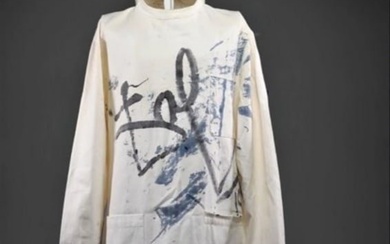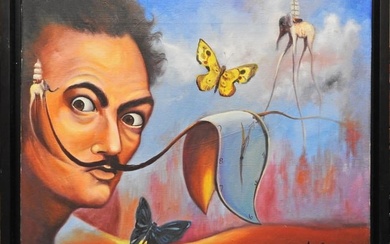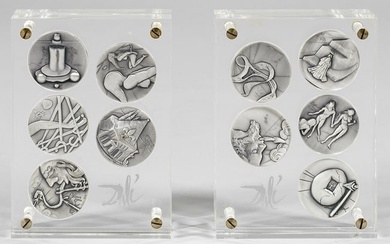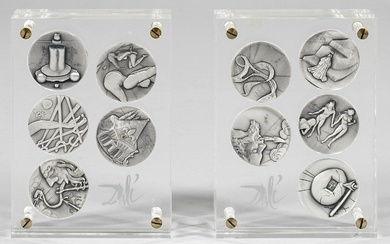Salvador Dali, (Spanish, 1904-1989)
Figura de perfil
Figura de perfil
signed and dated 'Salvador Dalí 1925' (upper right)
oil on board
74.2 x 50cm (29 3/16 x 19 11/16in).
Painted in El Sortell, Cadaqués, in 1925
The authenticity of this work has kindly been confirmed by Monsieur Nicolas Descharnes.
Provenance
Ana María Dalí Collection, the artist's sister, Spain (a gift from the artist).
Joaquim Cusí Furtunet Collection, Figueres (a gift from the above).
Private collection, Barcelona (acquired from the above, by 1950).
Thence by descent to the present owner.
Exhibited
Barcelona, Galeries Dalmau, Exposició S. Dalí, 14 - 27 November 1925, no. 10.
Literature
S. Gasch, 'Pintura Catalana II', in Atlántico, Madrid, 1929 (illustrated p. 74).
Fundació Gala-Salvador Dalí (eds.), Salvador Dalí, catalogue raisonné of paintings, Vol. I, 1910 to 1930, online catalogue, 2004, no. 147 (illustrated).
Exh. cat., Dalí inèdit: els dibuixos de Montserrat, Girona, 2007 (illustrated p. 25).
Figura de perfil was painted at El Sortell, a peninsula off Dalí's beloved Cadaqués, 'which I consider by far the most beautiful place in the world' (S. Dalí, The Secret Life of Salvador Dalí, New York, 1942, p. 167). The rocks and cove visible from the window appear in several works from the 1920s such as Portrait of the Cellist Ricardo Pichot, and indeed Dalí's close friend Ramon Pichot's family home was here. Although born in Figueres, a small Catalonian town north of Barcelona, Dalí loved spending his school holidays in the nearby fishing village of Cadaqués, where his father had been born and where the family had a small holiday house, 'El Llaner'. He spent many happy summers there and returned to the familiar coastline throughout his life, setting up his first home with Gala Eluard nearby at Port Lligat in 1930.
The young artist's earliest subjects were landscapes and portraits, predominantly of his sister, his cousin Montserrat, his parents, grandmother and of course, himself. The present work combines two favoured subjects, depicting his sister Ana María gazing steadfastly out of the window at the Cadaqués coastline beyond. This connection between family and landscape was expounded by Ana María herself who wrote, ''at that time my brother painted countless portraits of me. Many of them were simply studies of hair and a bared shoulder.' She recalled sitting for hours, gazing out at the countryside 'which has become a part of me for all time' as she held her pose. 'The fact is that Salvador invariably painted me at the window'' (R. Descharnes & G. Néret, Salvador Dalí 1904 - 1989, The Paintings, Vol. I, 1904 - 1946, Cologne, 2007, pp. 90 - 94). The window is given precedence in Figura de perfil, as the sparse interior ensures that we follow the sitter's gaze to the vivid blues and aquamarines of the harbour beyond.
The present work hailed from Dalí's sister's own collection, and has never before been seen on the market. Ana María was three years younger than the artist, whose older brother (also named Salvador) had died of gastroenteritis in infancy, just nine months before Dalí was born. Dalí painted Ana María regularly through the 1920s, and she would be his model until he met Gala in 1929. Dalí's ease in his sister's company allowed the artist to feel 'freer to indulge libidinous instincts', according to his personal secretary and biographer Robert Descharnes. Whilst only hinted at in the present work, in his portraits of women, nude or clothed, 'it is worth noting that Dalí's eye lingers over the derrière, and in his art he returns time and again to the rear view. In his sister, and Gala, and women in general, it is the posterior that interests him the most' (R. Descharnes & G. Néret, ibid., p. 70). Dalí said little to explain this tendency himself, but the present work is comparatively unusual in its more conservative placement of Ana María, who nevertheless sits at such an angle on the chair so as to push out and emphasise the size of her behind. This tendency would manifest itself ultimately in Young Virigin Autosodomized by her Own Chastity, a painting questioned to be an act of revenge.
The siblings' relationship was undoubtedly complicated by the artist's publication in 1942 of The Secret Life of Salvador Dalí, which Ana María believed to show the immoral and corrupting influence that both the Surrealist movement and Gala had had on her brother. In an effort to set the record straight she published her own account of their family's early life in 1949, Salvador Dalí visto por su Hermana (Salvador Dalí Seen by his Sister). Here she described not only her older brother's eccentricities and precocious demands as a spoilt child, but also the warmth of their parents love, tragically cut short by their mother's death in 1921 when she was thirteen and Dalí seventeen. Dalí himself was horrified by his sister's description of him and felt he had been cast in an unflattering light. The disintegration of their relationship is surely encapsulated by his decision to re-work his 1925 Figure at the Window, for which Ana María had sat and, inspired by a photograph from a 1930s pornographic magazine, create Young Virgin Autosodomized by her Own Chastity (1954). Emphasizing her rear, 'Ana María's firm, attractive behind is related to a rhinoceros horn, which in turn is related to fantasy images of an erection' (R. Descharnes & G. Néret, Salvador Dalí 1904 - 1989, The Paintings, Vol. II, 1946 - 1989, Cologne, 2007, p. 477).
The present work was painted in 1925, before the breakdown of their relationship. Indeed Dalí's first solo exhibition, held that year at the Galeries Dalmau in Barcelona, was to show a series of portraits of Ana María, including Figura de perfil. The show consisted of seventeen paintings and five drawings and, according to news coverage at the time, was declared a huge success.
The exhibition showed the artist's experimentation with a neo-classical style, looking back to the Masters in whom he was well versed. The composition chosen for the front cover of the Dalmau exhibition, Seated Girl, Seen from the Back (The Artist's Sister) has been likened in its precise detail to Vermeer (C. Rojas, Salvador Dalí, Or the Art of Spitting on Your Mother's Portrait, Pennsylvania, 1993, p. 79), but the artist to whom Dalí really paid homage in the show was Jean-Auguste-Dominique Ingres. Dalí recalled reading artist monographs in the laundry room of the family home that he had converted to a studio whilst a teenager: 'I came to know by heart all those pictures of the history of art, which have been familiar to me since my earliest childhood, for I would spend days contemplating them. The nudes attracted me above all else, and Ingres's Golden Age appeared to me the most beautiful picture in the whole world' (S. Dalí, op. cit., p. 71).
Dalí chose three quotes from Ingres to include in the 1925 exhibition catalogue, extolling the virtues of draughtsmanship and the contrasting beauty of full, round forms with linearity. Figura de perfil shows just such a juxtaposition between the hard lines of the window, wall and seat and the voluptuous curves of his sister's body. Light falls gently on her figure, illuminating the curve of her cheek, neck and shoulder. Ana María's hands appear carved out of sunlight, elegantly modelled and placed as carefully as a ballerina's: ''Only the hands show the touch of a master', Picasso's father had explained some twenty years earlier, unbeknown to Dalí at that time' (C. Rojas, op. cit., p. 78).
The present work shows a further classical influence in its composition, the window being placed at the height of the golden section, a framing device first used by da Vinci and Michelangelo. The harbour beyond is presented as a picture within a picture. In adopting such a style Dalí reflected the post-war trend for a classical realism, and specifically that of the Catalan movement 'Noucentisme', which originated largely as a reaction against Modernism and favoured a return to order.
By 1925 Dalí had already flown through an artistic journey spanning Impressionism, Pointillism, Fauvism and Cubism. Studying at the San Fernando Academy of Painting, Sculpture and Graphic Arts in Madrid had exposed the young artist to new ideas, people and styles. On admittance to the Residencia d'Estudiantes Dalí befriended Luis Buñuel and Federico García Lorca and changed his own personal style to embrace dandyism, slicking back his hair with egg white and launching himself on the local literary café scene. Dalí found the Academy itself old-fashioned however, writing in The Secret Life of Salvador Dalí of his surprise that his fellow students found Impressionism revolutionary, whereas 'this revolution of Impressionism was one which I had gone through at the age of twelve' (S. Dalí quoted in R. Descharnes & G. Néret, Salvador Dalí 1904 - 1989, The Paintings, Vol. I, 1904 - 1946, Cologne, 2007, p. 66).
Dalí goes on to recall taking a Georges Braque monograph into class one day, where it proved a revelation to the pupils and professor alike. The artist considered himself far ahead of his peers: 'I was already in full reaction against cubism. They, in order to reach cubism, would have had to live several lives!' (S. Dalí, op. cit., p. 161).
His first glimpse of Cubism had come from magazine articles and a catalogue given to him by Ramon Pichot, whose brother Pepito also brought back a copy of Umberto Boccioni's book, Pittura scultura futurista (dinamismo plastico) from Paris which the artist annotated throughout. Dalí pronounced his Self Portrait of 1920 'my first Cubist painting', and wrote of his admiration for the restrained palette of Juan Gris. Figura de perfil certainly shows the monochromes, ochres and muted olive greens which Dalí turned to as a reaction to his earlier Impressionist period, which allow the startling blue sea to punctuate. The precise detail with which Dalí renders his sister's hair, capturing even the individual hairs of her eyebrow, points...
View it on
Sale price
Time, Location
Auction House
Figura de perfil
Figura de perfil
signed and dated 'Salvador Dalí 1925' (upper right)
oil on board
74.2 x 50cm (29 3/16 x 19 11/16in).
Painted in El Sortell, Cadaqués, in 1925
The authenticity of this work has kindly been confirmed by Monsieur Nicolas Descharnes.
Provenance
Ana María Dalí Collection, the artist's sister, Spain (a gift from the artist).
Joaquim Cusí Furtunet Collection, Figueres (a gift from the above).
Private collection, Barcelona (acquired from the above, by 1950).
Thence by descent to the present owner.
Exhibited
Barcelona, Galeries Dalmau, Exposició S. Dalí, 14 - 27 November 1925, no. 10.
Literature
S. Gasch, 'Pintura Catalana II', in Atlántico, Madrid, 1929 (illustrated p. 74).
Fundació Gala-Salvador Dalí (eds.), Salvador Dalí, catalogue raisonné of paintings, Vol. I, 1910 to 1930, online catalogue, 2004, no. 147 (illustrated).
Exh. cat., Dalí inèdit: els dibuixos de Montserrat, Girona, 2007 (illustrated p. 25).
Figura de perfil was painted at El Sortell, a peninsula off Dalí's beloved Cadaqués, 'which I consider by far the most beautiful place in the world' (S. Dalí, The Secret Life of Salvador Dalí, New York, 1942, p. 167). The rocks and cove visible from the window appear in several works from the 1920s such as Portrait of the Cellist Ricardo Pichot, and indeed Dalí's close friend Ramon Pichot's family home was here. Although born in Figueres, a small Catalonian town north of Barcelona, Dalí loved spending his school holidays in the nearby fishing village of Cadaqués, where his father had been born and where the family had a small holiday house, 'El Llaner'. He spent many happy summers there and returned to the familiar coastline throughout his life, setting up his first home with Gala Eluard nearby at Port Lligat in 1930.
The young artist's earliest subjects were landscapes and portraits, predominantly of his sister, his cousin Montserrat, his parents, grandmother and of course, himself. The present work combines two favoured subjects, depicting his sister Ana María gazing steadfastly out of the window at the Cadaqués coastline beyond. This connection between family and landscape was expounded by Ana María herself who wrote, ''at that time my brother painted countless portraits of me. Many of them were simply studies of hair and a bared shoulder.' She recalled sitting for hours, gazing out at the countryside 'which has become a part of me for all time' as she held her pose. 'The fact is that Salvador invariably painted me at the window'' (R. Descharnes & G. Néret, Salvador Dalí 1904 - 1989, The Paintings, Vol. I, 1904 - 1946, Cologne, 2007, pp. 90 - 94). The window is given precedence in Figura de perfil, as the sparse interior ensures that we follow the sitter's gaze to the vivid blues and aquamarines of the harbour beyond.
The present work hailed from Dalí's sister's own collection, and has never before been seen on the market. Ana María was three years younger than the artist, whose older brother (also named Salvador) had died of gastroenteritis in infancy, just nine months before Dalí was born. Dalí painted Ana María regularly through the 1920s, and she would be his model until he met Gala in 1929. Dalí's ease in his sister's company allowed the artist to feel 'freer to indulge libidinous instincts', according to his personal secretary and biographer Robert Descharnes. Whilst only hinted at in the present work, in his portraits of women, nude or clothed, 'it is worth noting that Dalí's eye lingers over the derrière, and in his art he returns time and again to the rear view. In his sister, and Gala, and women in general, it is the posterior that interests him the most' (R. Descharnes & G. Néret, ibid., p. 70). Dalí said little to explain this tendency himself, but the present work is comparatively unusual in its more conservative placement of Ana María, who nevertheless sits at such an angle on the chair so as to push out and emphasise the size of her behind. This tendency would manifest itself ultimately in Young Virigin Autosodomized by her Own Chastity, a painting questioned to be an act of revenge.
The siblings' relationship was undoubtedly complicated by the artist's publication in 1942 of The Secret Life of Salvador Dalí, which Ana María believed to show the immoral and corrupting influence that both the Surrealist movement and Gala had had on her brother. In an effort to set the record straight she published her own account of their family's early life in 1949, Salvador Dalí visto por su Hermana (Salvador Dalí Seen by his Sister). Here she described not only her older brother's eccentricities and precocious demands as a spoilt child, but also the warmth of their parents love, tragically cut short by their mother's death in 1921 when she was thirteen and Dalí seventeen. Dalí himself was horrified by his sister's description of him and felt he had been cast in an unflattering light. The disintegration of their relationship is surely encapsulated by his decision to re-work his 1925 Figure at the Window, for which Ana María had sat and, inspired by a photograph from a 1930s pornographic magazine, create Young Virgin Autosodomized by her Own Chastity (1954). Emphasizing her rear, 'Ana María's firm, attractive behind is related to a rhinoceros horn, which in turn is related to fantasy images of an erection' (R. Descharnes & G. Néret, Salvador Dalí 1904 - 1989, The Paintings, Vol. II, 1946 - 1989, Cologne, 2007, p. 477).
The present work was painted in 1925, before the breakdown of their relationship. Indeed Dalí's first solo exhibition, held that year at the Galeries Dalmau in Barcelona, was to show a series of portraits of Ana María, including Figura de perfil. The show consisted of seventeen paintings and five drawings and, according to news coverage at the time, was declared a huge success.
The exhibition showed the artist's experimentation with a neo-classical style, looking back to the Masters in whom he was well versed. The composition chosen for the front cover of the Dalmau exhibition, Seated Girl, Seen from the Back (The Artist's Sister) has been likened in its precise detail to Vermeer (C. Rojas, Salvador Dalí, Or the Art of Spitting on Your Mother's Portrait, Pennsylvania, 1993, p. 79), but the artist to whom Dalí really paid homage in the show was Jean-Auguste-Dominique Ingres. Dalí recalled reading artist monographs in the laundry room of the family home that he had converted to a studio whilst a teenager: 'I came to know by heart all those pictures of the history of art, which have been familiar to me since my earliest childhood, for I would spend days contemplating them. The nudes attracted me above all else, and Ingres's Golden Age appeared to me the most beautiful picture in the whole world' (S. Dalí, op. cit., p. 71).
Dalí chose three quotes from Ingres to include in the 1925 exhibition catalogue, extolling the virtues of draughtsmanship and the contrasting beauty of full, round forms with linearity. Figura de perfil shows just such a juxtaposition between the hard lines of the window, wall and seat and the voluptuous curves of his sister's body. Light falls gently on her figure, illuminating the curve of her cheek, neck and shoulder. Ana María's hands appear carved out of sunlight, elegantly modelled and placed as carefully as a ballerina's: ''Only the hands show the touch of a master', Picasso's father had explained some twenty years earlier, unbeknown to Dalí at that time' (C. Rojas, op. cit., p. 78).
The present work shows a further classical influence in its composition, the window being placed at the height of the golden section, a framing device first used by da Vinci and Michelangelo. The harbour beyond is presented as a picture within a picture. In adopting such a style Dalí reflected the post-war trend for a classical realism, and specifically that of the Catalan movement 'Noucentisme', which originated largely as a reaction against Modernism and favoured a return to order.
By 1925 Dalí had already flown through an artistic journey spanning Impressionism, Pointillism, Fauvism and Cubism. Studying at the San Fernando Academy of Painting, Sculpture and Graphic Arts in Madrid had exposed the young artist to new ideas, people and styles. On admittance to the Residencia d'Estudiantes Dalí befriended Luis Buñuel and Federico García Lorca and changed his own personal style to embrace dandyism, slicking back his hair with egg white and launching himself on the local literary café scene. Dalí found the Academy itself old-fashioned however, writing in The Secret Life of Salvador Dalí of his surprise that his fellow students found Impressionism revolutionary, whereas 'this revolution of Impressionism was one which I had gone through at the age of twelve' (S. Dalí quoted in R. Descharnes & G. Néret, Salvador Dalí 1904 - 1989, The Paintings, Vol. I, 1904 - 1946, Cologne, 2007, p. 66).
Dalí goes on to recall taking a Georges Braque monograph into class one day, where it proved a revelation to the pupils and professor alike. The artist considered himself far ahead of his peers: 'I was already in full reaction against cubism. They, in order to reach cubism, would have had to live several lives!' (S. Dalí, op. cit., p. 161).
His first glimpse of Cubism had come from magazine articles and a catalogue given to him by Ramon Pichot, whose brother Pepito also brought back a copy of Umberto Boccioni's book, Pittura scultura futurista (dinamismo plastico) from Paris which the artist annotated throughout. Dalí pronounced his Self Portrait of 1920 'my first Cubist painting', and wrote of his admiration for the restrained palette of Juan Gris. Figura de perfil certainly shows the monochromes, ochres and muted olive greens which Dalí turned to as a reaction to his earlier Impressionist period, which allow the startling blue sea to punctuate. The precise detail with which Dalí renders his sister's hair, capturing even the individual hairs of her eyebrow, points...







